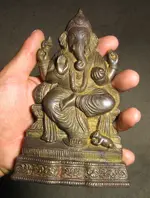From wikepedia
An annual festival honours Ganesha for ten days, starting on Ganesha Chaturthi, which typically falls in late August or early September.[SUP]
[128][/SUP] The festival begins with people bringing in clay idols of Ganesha, symbolising Ganesha's visit. The festival culminates on the day of
Ananta Chaturdashi, when idols (
murtis) of Ganesha are immersed in the most convenient body of water.[SUP]
[129][/SUP] Some families have a tradition of immersion on the 2nd, 3rd, 5th, or 7th day. In 1893,
Lokmanya Tilak transformed this annual Ganesha festival from private family celebrations into a grand public event.[SUP]
[130][/SUP] He did so "to bridge the gap between the
Brahmins and the non-Brahmins and find an appropriate context in which to build a new grassroots unity between them" in his nationalistic strivings against the British in
Maharashtra.[SUP]
[131][/SUP] Because of Ganesha's wide appeal as "the god for Everyman", Tilak chose him as a rallying point for Indian protest against British rule.[SUP]
[132][/SUP] Tilak was the first to install large public images of Ganesha in
pavilions, and he established the practice of submerging all the public images on the tenth day.[SUP]
[133][/SUP] Today, Hindus across India celebrate the Ganapati festival with great fervour, though it is most popular in the state of Maharashtra.[SUP]
[134][/SUP][SUP]
[135][/SUP] The festival also assumes huge proportions in
Mumbai,
Pune, and in the surrounding belt of Ashtavinayaka temples.
I guess some people loose them when they dunk them because I have found two in the last couple of years.






